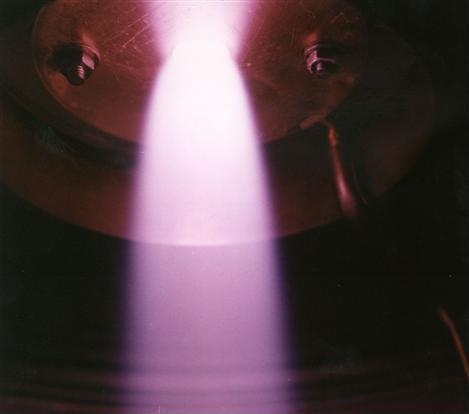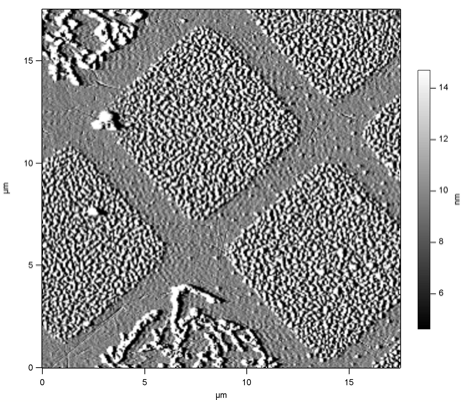Welcome!
The group "Surface and Plasma Technology" works in two main areas of research - plasma assisted deposition processes including aspects of plasma dynamics and plasma chemistry, and electron spectroscopy, including both, fundamental aspects of electron transport and the application for the analysis of surfaces and coatings.Work in the area of plasma chemistry is presently focused to halogen containing atmospheres, as these are technologically important for a variety of processes ranging from deposition and etching to chemical waste treatment. Besides the research in plasma chemistry, we are in the framework of scientific and technological cooperations working on applications of plasmas ranging from arc cutting torches and industrial deposition equipment to miniature plasmas used for chemical analysis systems on chips.
Research in electron spectroscopy focuses on the electron transport in solids and associated software technology. Important techological lines of work will be materials analysis with very high spatial resolution and the metallurgy of hard coatings. Analytical capabilities are made available to other scientists and industrial companies in the framework of scientific cooperations or as simple contract work. Most important among present cooperations are our contributions to the centre of competence for applied electrochemistry (ECHEM) and the centre of competence for tribology (AC2T).
Staff Members: Betz, Dobrozemsky, Gebeshuber, Laimer, Störi, Werner
Overview of our Research Activity
»
Overview of our Instrumentation and Service
Analysis »
Latest News
Download a free demo version of SESSA here5. May 2006 Database for electron spectroscopy
18. apr. 2006 Tutorial on electron spectroscopy by Wolfgang Werner
03. jan. 2006
SESSA released by NIST22 Dec. 2005 ECASIA'05
29 Sep 05
ECASIA05 Conference in Vienna organized by our group
Tribology
In close collaboration with the Austrian Center of Competence for Tribology we study tribologic films on real world samples using angle resolved electron spectroscopy for chemical analysis.Momentum Vector Spectroscopy
We build a novel experimental setup for measuring momentum vectors of electrons being emitted from well defined solid surfaces under the impact of energetic electrons or ions ("MOmentum VEctor Spectroscopy - MOVES").PACVD and Ellipsometry
Plasma-assisted chemical vapour deposition as well as plasma nitriding lack of an on-line process control. Therefore, we investigate the possibilities of spectroscopic ellipsometry for monitoring of surfaces under plasma treatment.

Simulation of Electron Spectra for Surface Analysis (SESSA)
A unique software tool for researchers active in the field of surface and interface analysis.Fundamental research in quantitative electron spectroscopy of solid surfaces
We measure characteristics of the electron-solid interaction and develop methods for spectrum simulation and quantitative spectrum interpretation.Interaction of beryllium with hydrogen plasma - nuclear fusion first wall investigations
After determination of the oxidation kinetics of beryllium in air, we are now investigating the interaction of beryllium with hydrogen plasma at temperatures around 400 °C in view of the suitability of beryllium as a first wall material for nuclear fusion devices.Analytical Micro-plasmas
We are developing plasma cells integrated into micro-fluidic devices for Lab-on-Chip applications in cooperation with CASECT Ltd. and R.I.C.Auger-Photoelectron Coincidence Spectroscopy (APECS)
Detailed information on the photoionization and Auger effect can be gained from APECS measurementsElectrochemical processes studied with in-situ XPS
In cooperation with the ECHEM - Center of Competence for Applied Electrochemistry we designed an apparatus to investigate the initial stages of the formation of electrochemical layers.PARASOL
Molecular Dynamics und Monte-Carlo calculations on the erosion (sputtering) from surfaces and the growth of thin films on single crystal substrates.Supersonic Vacuum Arc Jet
A plasma gun was developed which allows a supersonic expansion of the plasma plume into a vacuum vessel. It can be used for deposition experiments as well as plasma chemical investigations.

High temperature rf reactor
An electrodeless rf discharge can be sustained in a tubular fused silica reactor situated within an electric furnace with a temperature of up to 1100 °C. Samples can be treated with various process gas mixtures either without or with plasma activation.Mass spectrometry
The ultra high vacuum quadrupole mass spectrometers are used for a variety of analytical tasks, including process monitoring and outgasing.Scanning Auger Microscope - Focused Ion Beam
A state of the art high resolution Scanning Auger system (VG microlab 310F) has been equipped with a focussed ion beam column, permitting micro-machining of samples in situ. The system is available for service analyses.ESCA
We use the X-ray photoelectron spectrometer to do some basic research such as determining the surface electron interaction and applied research in the field of electrochemical deposition of thin films as well as the formation of tribologic films.Atmospheric Pressure Plasma Jet
We constructed an Atmospheric Pressure Plasma Jet to research stability conditions and behaviour of cold, atmospheric discharges.Optical Spectroscopy
The equipment available permits optical emission spectroscopy in the UV, visible and near infrared ranges from 185 to 1100 nm.Atomic Force Microscope
We have an ambient AFM combined with inverted optical microscope and top view optics.

